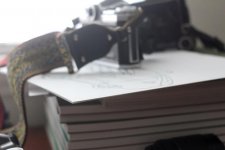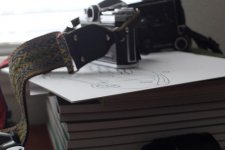Here we go yet again ... another confused thread regarding depth of field (DOF). What's a person to think about these apparently contradictory comments?
The OP has asked: "...what happens to DOF if you apply a 50 mm crop to a shot captured with a 28 mm lens? If you compare two shots taken of the same subject, at the same distance, with the same f/stop, one with a native 50 mm lens and the other with a 28 mm lens but cropped to correspond to the 50 mm shot, will the DOF be different?"
As with most DOF questions, the OP's question is not well-defined, not complete. Thus the question can have different correct answers whenever different responders complete the question with different unstated assumptions in getting their answer. But not all proposed answers are correct, however, and figuring out which is correct is another problem.
DOF is simple and well-defined and always yields a unique answer to any well-defined DOF question. The following is my attempt to explain it with very transparent concepts and very minimal mathematics. I've been working on this explanation for some time and now seems like a good time to try it out on you guys. Please let me know what you think of it.
Anyone who understands my explanation will be able to determine when DOF questions are well-defined and will be able to determine/calculate the unique answer to the well-defined ones. After presenting my explanation, I will use it to treat the OP's question and will present four examples that show how the answer can change dramatically as unstated assumptions change.
--- Mike
What IS depth of field? DOF exists only as a perception by a human viewer of a photographic image (negative or slide or print or electronic display). Consider a film negative, for simplicity. The objects recorded in the negative will be perfectly in-focus for only the single plane at the focus distance from the camera. Objects at all other distances from the camera will be out of focus, more so as their distance differs from the plane of focus. The image on the negative of every out-of-focus point will be blurred, becoming a blur circle instead of a point image, and will have a diameter that grows as the point is further from the plane of focus. Large out-of-focus objects will consist of a myriad of out-of-focus points which overlap and interfere with one another to make such large objects blurry. This much is a physical consequence of the way that photographic lenses work and films record lens images.
Human vision is limited in resolution; there's a limit to the size of things that one can see, blur circles included. So if a negative is viewed by a human from the closest distance at which he can focus his eyes, then the human will be able to resolve the large blur circles of some out-of-focus objects, and these objects will be perceived as out-of-focus. All the objects whose blur circles the human cannot resolve will be perceived as in-focus and the distances from the camera of these in-focus objects are within the DOF. The DOF thus is defined as the difference in distance from the camera between the nearest and the farthest objects which are perceived to be in-focus. If the human moves back from the negative, he will not be able to resolve some of the smaller blur circles that he could previously see, and the DOF will increase.
Now enlarge the negative to make a print. The blur circles will also be enlarged. This makes them easier for a human to resolve from the same close viewing distance, so the DOF will decrease. If the viewer moves back from the print, he will again not resolve some of the smaller blur circles and the DOF will increase.
So the DOF value depends on which blur circles in a photographic image a human viewer can perceive. Thus DOF is not a fixed property of a negative (or digital image). DOF is somehow related to the camera, a lens and an image (film or digital) they have produced. But DOF is also related to the human viewer and the viewing conditions. How to sort all this out?
We can identify exactly six independent factors which TOGETHER determine the DOF in a given situation. The six independent factors are the following, and we also list the INDIVIDUAL effect of changes to each factor on DOF when all the others are kept fixed.
1. focal length of the lens; longer focal length yields smaller DOF
2. f-stop of the lens; larger f-stop (smaller f-number) yields smaller DOF
3. focus distance setting of the lens; nearer focus distance yields smaller DOF
4. magnification of the viewed image; higher magnification yields smaller DOF
5. viewing distance to the viewed image; closer viewing distance yields smaller DOF
6. visual acuity of the viewer's eyes; people with 20/20 vision will experience a smaller DOF than all people with poorer vision and greater DOF than all people with better vision
The DOF involves all six of these factors. Change any one of them alone and the DOF changes. When you change more than one factor, the DOF can either increase or decrease depending on the degree to which the individual changes complement or oppose one another. Multiple changes can be complicated to treat. In many instances one cannot simply reason with just English (or any other language) to get a verifiably correct answer. Instead, one MUST use a mathematical treatment, a key result of which is given by this equation.
DOF = (2 * F^2 * f * D^2 * M * d *a) / (F^4 * M^2 - (f * D * d * a)^2)
where the value of each of the six factors is represented by a letter
F is the focal length of the lens
f is the f-number (1.4 or 8, for example)
D is the focus distance to the plane in focus (in the same units as F)
M is the magnification of the viewed image (M=1 for just a negative)
d is the viewing distance
a is human visual acuity (commonly about 0.00058, corresponding to 1/30°)
and * means multiply while x^2 = x * x, and x^4 = x * x * x * x
and (f * D * d * a)^2 means to multiply the four together and then square that
This equation is derived using simple geometrical optics. You can solve most common DOF questions by putting the appropriate values into this equation and calculating the result. But you must know the numerical values of all six factors to get any result at all; the question at issue must be well-defined.
Comments about the equation:
1. The equation applies to general photography for which the focus distance is much greater than the lens focal length (D>>F); the correct equation for macro work is slightly but importantly different and a bit more complicated.
2. The equation doesn't handle D = infinity very transparently; besides, if D=infinity then DOF=infinity, too, and no equation is needed.
3. If the calculated result of the equation is negative, that means that the DOF stretches to infinity.
4. Other DOF factors have been defined and used in other DOF equations, but the equation shown can accomplish everything that those others can and with fewer misunderstandings. For example DOF equations are often written in terms of something called the hyperfocal distance H, but the hyperfocal distance is just a special combination of our factors: H = F^2*M/(f*d*a). Similarly, the oft-defined circle of confusion c is just c = d*a/M.
Now apply this equation to the OP's question. We're going to calculate two values of DOF, one for the 50mm lens and one for the 28mm lens and then compare them. The OP told us that the f-number and focus distance are to be the same for both lenses but we weren't given values. Let's take f=4 and D = 3meter.
We already know that we need more information, and that the results of the comparison will depend on it. Let's assume a full frame film/sensor and magnify both of the negatives eight times (M=8) to make two prints that are 0.192m x 0.288m and we agree to view both from a distance equal to their common diagonal (d=0.346m). Further, we'll use the "standard" visual acuity (a=0.00058). Then our equations become
DOF(50) = (2 * 0.050^2 * 4 * 3^2 * 8 * 0.346 * 0.00058) / (0.050^4 * 8^2 - (4 * 3 * 0.00058 * 0.346)^2)
DOF(28) = (2 * 0.028^2 * 4 * 3^2 * 8 * 0.346 * 0.00058) / 0.028^4 * 8^2 - (4 * 3 * 0.346 * 0.00058)^2
and we can calculate the results which are
DOF(50) = 0.733 meter
DOF(28) = 2.08 meter
Comparing the two results, we find that the DOF of the 28mm lens is much greater than that of the 50mm lens. That is expected, because the only difference is focal length, and we already know generally how that affects DOF. Cropping in this example is just a matter of either masking the projected 28mm negative in the easel or trimming the print to show just the part of the 28mm negative that is included as the entire 50mm negative. After cropping, the 28mm print will be about 146mm x 219mm, which is smaller than the 50mm print. It's smaller, because the portion of a 28mm negative that matches an entire 50mm negative is only about 76% of each side of the 28mm negative (and 0.76^2 = 58% of the 28mm negative's area). But we still view it from 0.346m.
Next consider making the just cropped portion of the 28mm print the same size as the 50mm print when the 50mm is magnified 8 times. This will require a magnification for the 28mm of 8/0.76 = 10.5; all other factors retain the same values. In this case, the equation give
DOF(50) = 0.733 meter
DOF(28) = 1.919 meter
The 28mm print still has much greater DOF than the 50mm print.
Next suppose we magnify the 28mm negative by 20.8 while keeping all the other factors the same as before. Then the results are
DOF(50) = 0.733 meter
DOF(28) = 0.733 meter
Now the 50mm DOF is the same as the 28mm DOF. Again, cropping amounts to masking or trimming the 28mm image to match the extent of the 50mm image, and the print size will be about 0.380m x 0.570m, almost twice as large as the 50mm print but showing the same scene. Again we view both from 0.346m.
If we magnify the 28mm negative by 25 while keeping all else constant, the results will be
DOF(50) = 0.733 meter
DOF(28) = 0.608 meter
and the 50mm DOF is greater than the DOF of the 28mm.
To make the 28mm print have the same DOF as the 50mm, one must magnify the 28mm negative 2.6 times more than the 50mm negative. The mathematical reason why one must magnify the 28mm negative so much more is that the DOF depends on F^2 * M and (F^2 * M)^2. Thus if the focal length changes by a factor of 50/28 = 1.79 as in the OP's question, then the magnification must change by a factor of 1.79^2=3.19 to keep the product of these two factors constant. But since the denominator of the equation includes a second, negative term not involving F and M, this calculated 3.19 factor actually only needs to be 2.6 to accomplish equal DOFs.
So, in summary, the OP's question was ambiguous and the DOF of the 28mm can be greater than, the same as, or smaller than the DOF of the 50mm, depending on the values of the factors which the OP didn't specify but which are necessary for a well-posed question that this or any other DOF equation can answer. One can calculate comparisons for many other interesting situations involving these two lenses or for any other well-defined situation using the equation given.






